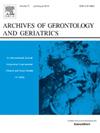Predicting delirium in older adults with community-acquired pneumonia: A retrospective analysis of stress hyperglycemia ratio and its interactions with nutrition and inflammation
IF 3.5
3区 医学
Q2 GERIATRICS & GERONTOLOGY
引用次数: 0
Abstract
Background
Community-acquired pneumonia (CAP) increases mortality risk in older patients, often complicated by delirium. Key risk factors include malnutrition and glucose metabolism disorders. This study examines the Stress Hyperglycemia Ratio (SHR) as a predictive marker for delirium in older CAP patients and its role in clinical risk management.
Methods
In this retrospective study, we analyzed patients aged 65 and older diagnosed with CAP at the Second People's Hospital of Lianyungang. Delirium was evaluated using the Confusion Assessment Method (CAM) based on DSM-5 criteria. We assessed clinical data, including nutritional status, SHR, and Interleukin-6 (IL-6) levels. Nutritional status was measured using the Mini Nutritional Assessment Short Form (MNA-SF). Statistical analyses including logistic regression, Receiver Operating Characteristic (ROC) analysis, and mediation analyses were used to ascertain the predictive value of SHR and its interaction with other delirium risk factors.
Results
The average age of the cohort was 84.20 ± 5.15 years, with a delirium incidence of 19.68 % and a 28-day mortality rate of 11.16 %. Both SHR and IL-6 were significant risk factors for delirium, while higher MNA-SF scores were protective. An SHR of 1.12 or greater indicated an elevated risk of delirium. Combined assessments of SHR, IL-6, and MNA-SF enhanced predictive accuracy, achieving an AUC of 0.723. SHR and IL-6 independently and synergistically influenced the relationship between nutritional status and delirium onset.
Conclusion
SHR is a crucial risk factor for delirium in older CAP patients, interacting with nutritional and inflammatory markers. Integrating SHR with nutritional and inflammatory assessments can enhance early risk identification and improve clinical outcomes for this vulnerable group.
社区获得性肺炎老年人谵妄的预测:压力性高血糖比率及其与营养和炎症相互作用的回顾性分析。
背景:社区获得性肺炎(CAP)会增加老年患者的死亡风险,通常会并发谵妄。主要风险因素包括营养不良和糖代谢紊乱。本研究探讨了应激性高血糖比值(SHR)作为老年 CAP 患者谵妄的预测指标及其在临床风险管理中的作用:在这项回顾性研究中,我们分析了在连云港市第二人民医院确诊的 65 岁及以上 CAP 患者。根据DSM-5标准,使用意识模糊评估法(CAM)对谵妄进行评估。我们评估了临床数据,包括营养状况、SHR和白细胞介素-6(IL-6)水平。营养状况采用迷你营养评估简表(MNA-SF)进行测量。统计分析包括逻辑回归、Receiver Operating Characteristic(ROC)分析和中介分析,以确定SHR的预测价值及其与其他谵妄风险因素的相互作用:组群的平均年龄为 84.20 ± 5.15 岁,谵妄发生率为 19.68%,28 天死亡率为 11.16%。SHR和IL-6都是导致谵妄的重要风险因素,而较高的MNA-SF评分则具有保护作用。SHR大于或等于1.12表明谵妄风险升高。综合评估SHR、IL-6和MNA-SF可提高预测准确性,AUC达到0.723:结论:SHR 是老年 CAP 患者出现谵妄的关键风险因素,与营养和炎症指标相互作用。将 SHR 与营养和炎症评估结合起来,可以加强对这一弱势群体的早期风险识别,改善临床疗效。
本文章由计算机程序翻译,如有差异,请以英文原文为准。
求助全文
约1分钟内获得全文
求助全文
来源期刊
CiteScore
7.30
自引率
5.00%
发文量
198
审稿时长
16 days
期刊介绍:
Archives of Gerontology and Geriatrics provides a medium for the publication of papers from the fields of experimental gerontology and clinical and social geriatrics. The principal aim of the journal is to facilitate the exchange of information between specialists in these three fields of gerontological research. Experimental papers dealing with the basic mechanisms of aging at molecular, cellular, tissue or organ levels will be published.
Clinical papers will be accepted if they provide sufficiently new information or are of fundamental importance for the knowledge of human aging. Purely descriptive clinical papers will be accepted only if the results permit further interpretation. Papers dealing with anti-aging pharmacological preparations in humans are welcome. Papers on the social aspects of geriatrics will be accepted if they are of general interest regarding the epidemiology of aging and the efficiency and working methods of the social organizations for the health care of the elderly.

 求助内容:
求助内容: 应助结果提醒方式:
应助结果提醒方式:


